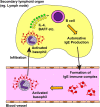Role of Basophils in a Broad Spectrum of Disorders
- PMID: 35693800
- PMCID: PMC9186123
- DOI: 10.3389/fimmu.2022.902494
Role of Basophils in a Broad Spectrum of Disorders
Abstract
Basophils are the rarest granulocytes and have long been overlooked in immunological research due to their rarity and similarities with tissue-resident mast cells. In the last two decades, non-redundant functions of basophils have been clarified or implicated in a broad spectrum of immune responses, particularly by virtue of the development of novel analytical tools for basophils. Basophils infiltrate inflamed tissues of patients with various disorders, even though they circulate in the bloodstream under homeostatic conditions. Depletion of basophils results in the amelioration or exaggeration of inflammation, depending on models of disease, indicating basophils can play either beneficial or deleterious roles in a context-dependent manner. In this review, we summarize the recent findings of basophil pathophysiology under various conditions in mice and humans, including allergy, autoimmunity, tumors, tissue repair, fibrosis, and COVID-19. Further mechanistic studies on basophil biology could lead to the identification of novel biomarkers or therapeutic targets in a broad range of diseases.
Keywords: COVID-19; IL-4; allergy; autoimmune diseases; basophils; fibrosis; tissue repair; tumor.
Copyright © 2022 Miyake, Ito and Karasuyama.
Conflict of interest statement
The authors declare that the research was conducted in the absence of any commercial or financial relationships that could be construed as a potential conflict of interest.
Figures



Similar articles
-
Basophils beyond allergic and parasitic diseases.Front Immunol. 2023 May 2;14:1190034. doi: 10.3389/fimmu.2023.1190034. eCollection 2023. Front Immunol. 2023. PMID: 37205111 Free PMC article. Review.
-
Basophils and their effector molecules in allergic disorders.Allergy. 2021 Jun;76(6):1693-1706. doi: 10.1111/all.14662. Epub 2020 Nov 29. Allergy. 2021. PMID: 33205439 Review.
-
[Recent advances in understanding of basophil function and differentiation].Nihon Yakurigaku Zasshi. 2024;159(1):32-38. doi: 10.1254/fpj.23084. Nihon Yakurigaku Zasshi. 2024. PMID: 38171836 Review. Japanese.
-
Basophils, a neglected minority in the immune system, have come into the limelight at last.Int Immunol. 2021 Nov 25;33(12):809-813. doi: 10.1093/intimm/dxab021. Int Immunol. 2021. PMID: 34038539 Review.
-
Nonredundant roles of basophils in immunity.Annu Rev Immunol. 2011;29:45-69. doi: 10.1146/annurev-immunol-031210-101257. Annu Rev Immunol. 2011. PMID: 21166539 Review.
Cited by
-
Prognostic factors and prognostic model of non-metastatic clear cell renal cell carcinoma.BMC Cancer. 2024 Oct 10;24(1):1263. doi: 10.1186/s12885-024-12922-2. BMC Cancer. 2024. PMID: 39390388 Free PMC article.
-
Basophils control T cell priming through soluble mediators rather than antigen presentation.Front Immunol. 2023 Feb 9;13:1032379. doi: 10.3389/fimmu.2022.1032379. eCollection 2022. Front Immunol. 2023. PMID: 36846020 Free PMC article. Review.
-
Basophils beyond allergic and parasitic diseases.Front Immunol. 2023 May 2;14:1190034. doi: 10.3389/fimmu.2023.1190034. eCollection 2023. Front Immunol. 2023. PMID: 37205111 Free PMC article. Review.
-
Novel insights into the ontogeny of basophils.Front Allergy. 2024 May 13;5:1402841. doi: 10.3389/falgy.2024.1402841. eCollection 2024. Front Allergy. 2024. PMID: 38803659 Free PMC article. Review.
-
A Two-Sample Mendelian Randomization Study of Basophil Count and Risk of Gestational Diabetes Mellitus.Int J Womens Health. 2025 Feb 26;17:517-527. doi: 10.2147/IJWH.S500632. eCollection 2025. Int J Womens Health. 2025. PMID: 40028461 Free PMC article.
References
Publication types
MeSH terms
LinkOut - more resources
Full Text Sources
Medical

